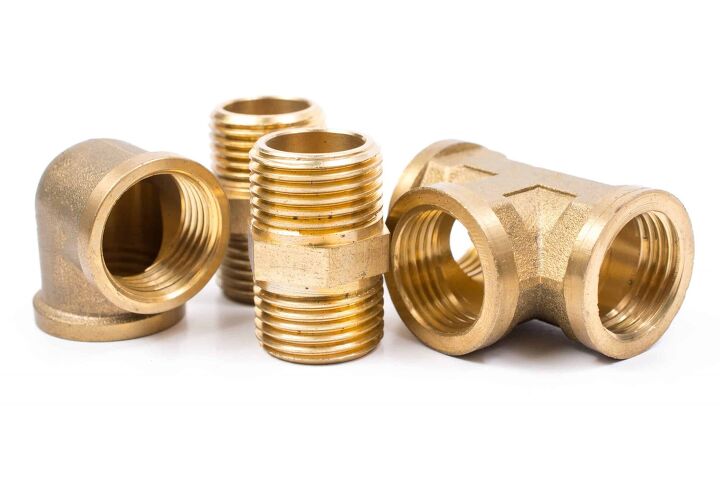Should I Use Teflon Tape On Brass Fittings?

Teflon tape, commonly referred to as plumber’s tape, is implemented when connecting metal plumbing pipes in order to reduce the risk of leaks. In general, Teflon tape is recommended to be used on most threaded connections that do not have a rubber gasket.
If you’re inquiring about brass fittings, Teflon tape is only necessary if there isn’t already a built-in rubber seal. However, it can still be beneficial since it provides lubrication to the connection, making the threading much smoother.
Teflon tape will also prevent your brass pipes from sticking, should you ever need to disassemble a joint. Just like anything, there is a wrong and right way to apply Teflon tape. Regardless, it is a very simple product to use and we will outline exactly how it should be applied on your brass fittings.
Do You Need to Hire a Plumber?
Get free, zero-commitment quotes from pro plumber near you.

What is Teflon Tape?
Much like Kleenex, “Teflon” is actually a brand name that is used universally to refer to plumber’s tape or any tape that is labeled “PTFE” or “PolyTetraFluoroEthylene.” It is most prevalently used as a way to prevent leaks from occurring between the connections of metal pipe fittings.
Surrounding the male threads of one pipe with Teflon tape adds more lubrication and creates a smoother surface, making it much easier to install it into the female threads of another pipe. If you ask for “Teflon tape” at any home improvement or hardware center, you will find what you need. However, no products exist that actually carry that name.
DuPont, the manufacturer of Teflon, never actually made plumber’s tape. Back in the 1960s, tape companies used DuPont’s Teflon product in powder form and applied it to their own plumber’s tape. These companies were permitted to use the Teflon name when referring to their tape only if they actually used the product in its development.
Since then, knockoff versions have been created of the same material, and since they cannot use the brand name, you won’t find any tape labeled “Teflon” on the market. Instead, it’s often referred to as thread-sealing tape or thread seal tape, indicating exactly what it’s used for.
How to Use Teflon Tape with Brass Fittings
Proper use of Teflon tape with brass fittings is to wrap it around the pipe that will be inserted into the fitting. The trick to get it exactly right involves wrapping the pipe in the correct direction. Then, when the pipe is installed into the fitting, the friction created will work to tighten the tape around the pipe and solidify the connection.
To do this, the Teflon tape should be wound around the pipe in a way that is opposite of the direction that it will be turned into the brass fitting.
For appropriate use of Teflon tape, follow these steps:
- Use a clean cloth to wash the threads of your pipe and fitting. Remove any material that could obstruct a secure connection.
- Examine the thread direction. While most pipe threads run clockwise, some may be constructed differently. Before applying tape, you always want to check which direction the grooves are going. Make a note of which way you will need to turn the male piece in order for it to correctly screw into the female side.
Quick Tip: Teflon tape should always be installed in the direction of the threads that you are applying it to. In most cases, the direction is clockwise.
- Start wrapping the end of the male threads by lining up the edge of the tape perfectly with the pipe’s edge. Ensure that none of the tape protrudes out over the edge of the pipe. If it does, peel off the tape and start again.
- Continue wrapping by following the direction of the threads. Make sure that you shift slightly with each layer to ensure ample coverage of the threads.
Quick Tip: As you are wrapping the Teflon tape, continuously pull the tape taut. This will guarantee that all the grooves and ridges are adequately covered.
- After you’ve done about five or six turns and the threads are completely concealed, cut the tape off from the roll and pull tightly to secure the last threads.
- If the connection you are making needs a more permanent seal, apply pipe dope on top of the layer of Teflon tape. However, avoid using any liquid sealant for pipes that will carry drinking water. You don’t want to cause any sort of contamination by introducing pipe dope into your drinking lines.
With the pipe tightly wrapped, you can now insert it into the brass fitting and turn to secure. If you notice that the Teflon tape is loose at any point, you should unwind the tape and start fresh with a new strip of tape.
Teflon Tape Color Categorization
Over fifty years ago, color codes were established for thread-sealing tape. While most often you’ll find Teflon tape in white, there are several colors that correspond to coded pipelines. The most common categories include:
- White: White tapes are the most common type of plumber’s tape and are used on American National Standard Pipe Thread, or National Pipe Thread (NPT). They are generally applied to threads that are no more than 3/8 inch.
- Green: Green tapes implement PTFE that is oil-free. This type of Teflon tape is typically used on oxygen threads or for specific medical purposes.
- Yellow: Often referred to as gas tape, yellow plumber’s tape is used on NPT threads between ½ inch and 2 inches.
- Pink: Pink tapes are a safer option for use on potable water. Similar to yellow, pink tapes are also used on ½ inch to 2-inch threads.
- Copper: Copper-colored plumber’s tape is constructed from copper particles. This type of Teflon tape is not recognized as a sealant and is only used as a lubricant for threads.
- Grey: Grey-colored tapes have nickel in them and offer anti-corrosion properties. Grey tape is best used on stainless pipes.
- Blue: Although less common, blue tape is implemented for general use and is denser and thicker than conventional Teflon tape.
Teflon tape comes in a variety of colors, widths, and thicknesses. Whatever the intended purpose, there is likely a type that will satisfy your needs and effectively stop your pipes from leaking over time.
When Not to Use Teflon Tape
Teflon tape is an essential tool for making water-tight plumbing connections. However, there are some instances where it should be used carefully or not at all. If too many wraps are made around the pipe, you can actually prevent the threads from engaging entirely. Do enough wraps to cover the threads, but not too many that could hinder a sufficient connection.
Teflon tape is only recommended to be used on NPT or NPTF (National Pipe Taper Fuel) threads. Both are indicative of their tapered threads. You should avoid using plumber’s tape on any other type of thread such as AN (Army/Navy), GHT (Garden-Hose Thread), BSPT (British Standard-Taper Pipe-Thread), and more.
Do You Need to Hire a Plumber?
Get free, zero-commitment quotes from pro plumber near you.

Wrapping It Up
As long as your brass fittings do not already have a rubber gasket, it is recommended and necessary to use Teflon tape in accordance with them. Teflon tape helps to create a water-tight seal and makes connections smooth and effortless. Apply the Teflon tape in the direction of the male threads, most often clockwise. Then, you can simply insert the pipe into your brass fitting and the result is a secure, waterproof seal.
For more plumbing tips, check out: “ How To Install Sharkbite Fittings On A Copper Pipe or “ Why Are My Sharkbite Fittings Leaking?”
Related Guides

Jessica considers herself a home improvement and design enthusiast. She grew up surrounded by constant home improvement projects and owes most of what she knows to helping her dad renovate her childhood home. Being a Los Angeles resident, Jessica spends a lot of her time looking for her next DIY project and sharing her love for home design.
More by Jessica Stone




















![Cost To Drill A Well [Pricing Per Foot & Cost By State]](https://cdn-fastly.upgradedhome.com/media/2023/07/31/9074980/cost-to-drill-a-well-pricing-per-foot-cost-by-state.jpg?size=350x220)






